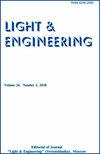The Influence of Multi-Storey Surrounding Development on a Daylighting of Interiors in Top-Lit Premises: An Experimental Study
IF 0.3
4区 工程技术
Q4 ENGINEERING, ELECTRICAL & ELECTRONIC
引用次数: 0
Abstract
To ensure a required daylight in premises with top system of outdoor illumination through roof lighting installations, it is necessary to take into account the photometrical effects of surrounding development. For the time being such a concept in lighting engineering design is adopted only for side lit premises through windows, though the dense urban development in modern megalopolises offers nearly the same problem for buildings with overhead daylighting system. This paper presents a brief description of experimental case studies, based on the scale model method, as well as on the photometric studies of a real premise with skylights. The studies were conducted in both cases under CIE standard overcast sky with changing geometrics and photometrical parameters of model elements. The results of the studies showed the great photometric influence of opposite-standing objects on the values of daylight factor (D) in premises with top lighting system and dependence of this influence on size, position, and structural type of skylights, as well as on size and finishing of the model parts and on distance between skylights and opposite-standing building.多层周边发展对顶光住宅室内采光的影响:一项实验研究
为确保在设有屋顶照明装置的屋顶室外照明系统的处所获得所需的日光,必须考虑到周围发展的光度效应。目前,照明工程设计中的这种概念仅适用于通过窗户的侧照明场所,尽管现代大都市的密集城市发展为带有顶灯采光系统的建筑物提供了几乎相同的问题。本文简要介绍了基于比例模型方法的实验案例研究,以及对一个有天窗的真实前提的光度研究。两种情况下的研究都是在CIE标准阴天下进行的,模型元素的几何形状和光度参数都发生了变化。研究结果表明,在具有顶灯系统的房屋中,相对放置的物体对日光因子(D)值有很大的光度影响,这种影响与天窗的大小、位置和结构类型、模型部件的大小和精加工以及天窗与相对放置的建筑物之间的距离有关。
本文章由计算机程序翻译,如有差异,请以英文原文为准。
求助全文
约1分钟内获得全文
求助全文
来源期刊

Light & Engineering
ENGINEERING, ELECTRICAL & ELECTRONIC-OPTICS
CiteScore
1.00
自引率
50.00%
发文量
0
审稿时长
1 months
期刊介绍:
Our magazine
develops comprehensive communication within the lighting community, providing opportunities for discussion and free expression of opinions of specialists of different profiles;
contributes to the convergence of science and engineering practice, the search for opportunities for the application of research results in lighting and technological applications of light;
keeps the scientific community up to date with the latest advances in the theory of the light field, providing readers with operational professional information;
initiates international cooperation, promotes and distributes the results of Russian authors in the international professional community;
provides equal opportunities for authors from different regions of Russia and other countries.
The journal publishes articles in the following areas:
visual and non-visual effects of radiation on humans;
light field theory;
photometry and colorimetry;
sources of light;
ballasts;
light devices, their design and production technology;
lighting and irradiation installation;
light signaling;
methods of mathematical modeling of light devices and installations;
problems of energy saving in lighting, installation and operation of lighting installations;
modern production technologies of lighting products for lighting control systems;
innovative design solutions;
innovations in lighting and lighting design;
the study of the effect on plants and animals, problems of using light in medicine;
problems of disinfection of premises, water and smell elimination with the help of technology of UV radiation using;
problems of light in the ocean and space.
 求助内容:
求助内容: 应助结果提醒方式:
应助结果提醒方式:


